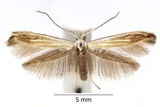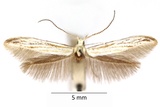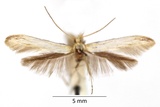Coleophora betulella Heinemann, [1876] Species
Last modified: Nov. 27, 2025, 7:43 p.m.
A very rare species in Belgium.
Details
- Classification
- Family: Coleophoridae > Genus: Coleophora > Species: Coleophora betulella
- Vernacular names
- Witte berkenkokermot (NL), White birch case-bearer (EN), Weiße Birken-Sackmotte (DE)
- First mention in Belgium
- De Prins W. 1999. Correcties en aanvullingen op de “Catalogue of the Lepidoptera of Belgium”. — Phegea 27(1): 25–28. On page 26 (as Coleophora betulella Heinemann & Wocke, 1877). view page
- Status
-
Native
Distribution
Egg
The egg is nipple-shaped.
Caterpillar
The yellowish brown larva has a black head and black prothoracic plate.
Case
The black case is pistol-shaped, black, laterally compressed at the bi-valved end measures circa 7 mm when it reaches its maximal size.
The mouth angle is 30–45°.
See also bladmineerders.be.
Bionomics
The eggs are deposited at the underside of the leaf. The young larvae make, before overwintering, small mines. From mid April they resume their activities but, by then, small leaves are eaten starting from the leaf-edge. Eventually, window feeding is done, usually at the bottom of the sheet. They are full grown by the end of May or early June.
Pupation takes place inside the case, mostly at the upper side of a leaf or, more seldom, against a twig.
Flight periods
The adults fly in June and July.
Observed on
- Host plant (genera):
- Betula
This species feeds monophagously on Betula.



